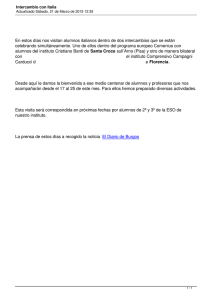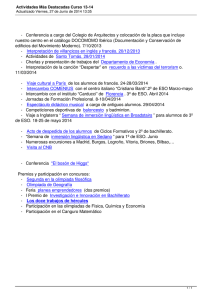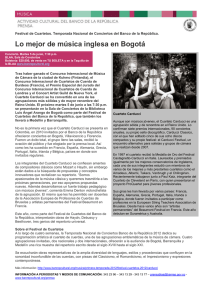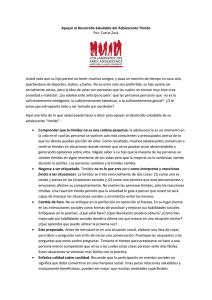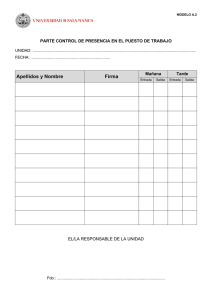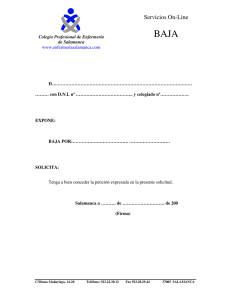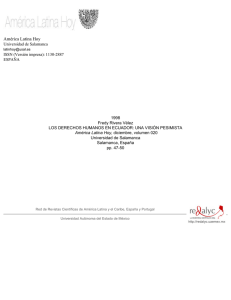2022911_Cub Historia Pirateria
Anuncio
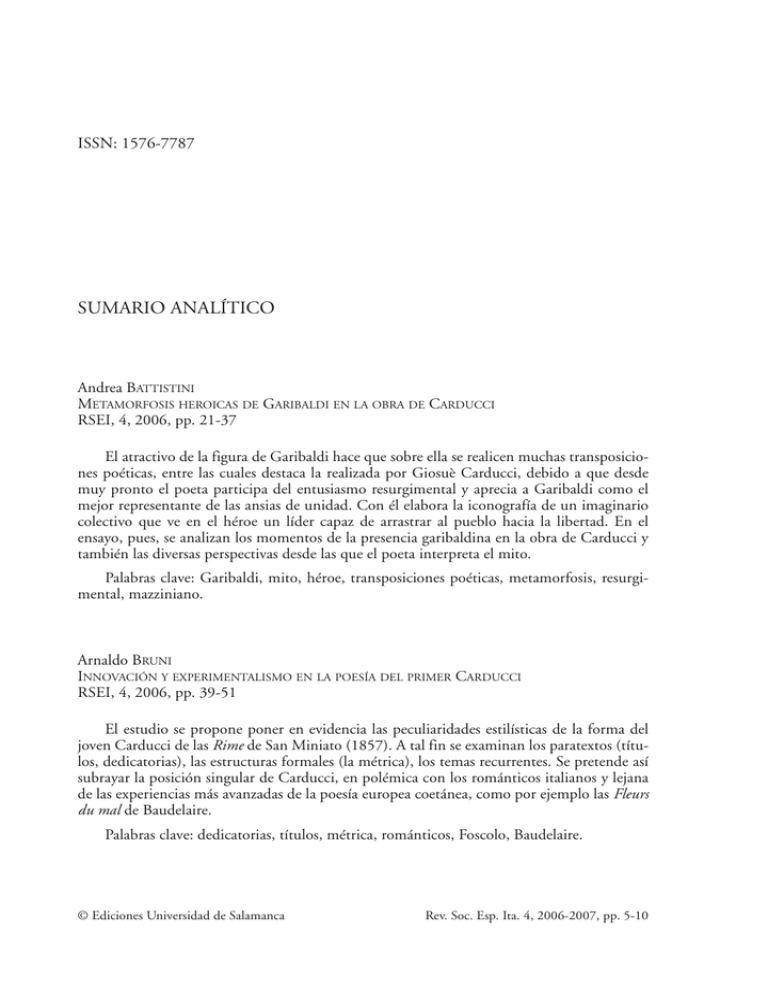
ISSN: 1576-7787 SUMARIO ANALÍTICO Andrea BATTISTINI METAMORFOSIS HEROICAS DE GARIBALDI EN LA OBRA DE CARDUCCI RSEI, 4, 2006, pp. 21-37 El atractivo de la figura de Garibaldi hace que sobre ella se realicen muchas transposiciones poéticas, entre las cuales destaca la realizada por Giosuè Carducci, debido a que desde muy pronto el poeta participa del entusiasmo resurgimental y aprecia a Garibaldi como el mejor representante de las ansias de unidad. Con él elabora la iconografía de un imaginario colectivo que ve en el héroe un líder capaz de arrastrar al pueblo hacia la libertad. En el ensayo, pues, se analizan los momentos de la presencia garibaldina en la obra de Carducci y también las diversas perspectivas desde las que el poeta interpreta el mito. Palabras clave: Garibaldi, mito, héroe, transposiciones poéticas, metamorfosis, resurgimental, mazziniano. Arnaldo BRUNI INNOVACIÓN Y EXPERIMENTALISMO EN LA POESÍA DEL PRIMER CARDUCCI RSEI, 4, 2006, pp. 39-51 El estudio se propone poner en evidencia las peculiaridades estilísticas de la forma del joven Carducci de las Rime de San Miniato (1857). A tal fin se examinan los paratextos (títulos, dedicatorias), las estructuras formales (la métrica), los temas recurrentes. Se pretende así subrayar la posición singular de Carducci, en polémica con los románticos italianos y lejana de las experiencias más avanzadas de la poesía europea coetánea, como por ejemplo las Fleurs du mal de Baudelaire. Palabras clave: dedicatorias, títulos, métrica, románticos, Foscolo, Baudelaire. © Ediciones Universidad de Salamanca Rev. Soc. Esp. Ita. 4, 2006-2007, pp. 5-10 6 SUMARIO ANALÍTICO Assumpta CAMPS OLIVÉ LA RECEPCIÓN LITERARIA COMO INSTRUMENTALIZACIÓN. EL CASO DE GIOSUÈ CARDUCCI EN CATALUÑA RSEI, 4, 2006, pp. 53-70 En este ensayo nos proponemos estudiar la recepción literaria de G. Carducci en Cataluña, en ocasión del centenario de su muerte. Partiendo de la convicción que toda recepción conlleva, en mayor o menor grado, la instrumentalización de un autor y su obra en el contexto de acogida, analizaremos las alusiones al escritor italiano que aparecen en dos autores que entre el siglo XIX y el XX se refieren frecuentemente a él en ámbito catalán: Diego Ruiz Rodríguez y Miquel Costa i Llobera. De la comparación entre ambos se podrá apreciar la diferente significación que adquiere Carducci entre nosotros en esos años, y la imagen que se construye de él por entonces. Palabras clave: recepción, Cataluña, Diego Ruiz, Miquel Costa, comparación. Renzo CREMANTE CARDUCCI PROFESOR: LOS COMIENZOS DE SU ENSEÑANZA BOLOÑESA RSEI, 4, 2006, pp. 71-82 El ensayo analiza la experiencia de Giosuè Carducci como profesor de Literatura italiana de la Universidad de Bolonia, a partir de 1860, y especialmente su manera inicial de insertarse en una Universidad de antiguas tradiciones, pero inmersa en un movimiento de renovación importante. El autor va analizando las sensaciones que la ciudad de Bolonia suscitó en el joven poeta profesor, sus críticas a la penuria de medios científicos de la Universidad, la falta de modernidad de los métodos de enseñanza y su aplicación en la búsqueda de un método filológico riguroso y acorde con los tiempos. Para ello se basa en su amplio conocimiento de la poesía italiana y en su capacidad de proyectar la literatura hacia panoramas históricos y sociales. Palabras clave: literatura italiana, métrica, universidad, metodología, sociología, política. © Ediciones Universidad de Salamanca Rev. Soc. Esp. Ita. 4, 2006-2007, pp. 5-10 7 SUMARIO ANALÍTICO Miquel EDO I JULIA LA LITERATURA CATALANA FRENTE AL MODELO RETÓRICO CARDUCCIANO RSEI, 4, 2006, pp. 83-100 Carducci sirvió de modelo, a principios del siglo XX, para elevar el registro del catalán literario, hasta entonces fuertemente vinculado a la leyenda y a la canción popular. En ocasiones, las propuestas métricas y la alta retórica del poeta «bárbaro» fueron adoptadas en polémica con el decadentismo; en otras ocasiones incluso desde dentro de él. Prevaleció en algunos autores un énfasis oratorio de carácter político; en otros, un elitismo de corte clasicista. Gozó, en cualquier caso, tanto entre los modernistas como entre los poetas de la Escola Mallorquina, de un prestigio que alcanzó su mayor auge en torno a 1907, año de su muerte, para decrecer rápidamente a lo largo de las décadas siguientes ante el empuje de las corrientes antiheroicas e intimistas, dentro de las cuales no dejaron de producirse, sin embargo, esporádicos retornos al carduccianismo, a modo de reacción frente a determinadas derivaciones de las nuevas tendencias. Palabras clave: Carducci, bárbaro, clasicismo, Modernismo, Escola Mallorquina, retórica. Vicente GONZÁLEZ MARTÍN ALGUNOS ASPECTOS DE LA PRESENCIA DE «L’INNO A SATANA» DE CARDUCCI EN LA LITERA- TURA ESPAÑOLA RSEI, 4, 2006, pp. 101-112 La presencia de Carducci en la literatura española fue intensa y ha sido bien estudiada en sus aspectos generales. Sin embargo, este estudio analiza ese tipo de literatura carducciana, representado por el Inno a Satana, que suscitó un cierto rechazo por la carga de impiedad que podía deducirse del mismo título, analizando cómo personajes relevantes de la literatura española como Juan Valera y Miguel de Unamuno interpretan el poema, lo sitúan y lo ponderan en su justa medida, minimizando las características de ataque a la moralidad imperante en la época y valorándolo como un ejercicio literario bien construido y como arranque de la poderosa obra carducciana. Palabras clave: Satanás, Santa Teresa, progreso, moralidad, impiedad, ferrocarril, comparación. © Ediciones Universidad de Salamanca Rev. Soc. Esp. Ita. 4, 2006-2007, pp. 5-10 8 SUMARIO ANALÍTICO VARIA Laura CARLUCCI LO REAL Y LO FANTÁSTICO EN LAS NOVELLE DI SER GIOVANNI FIORENTINO RSEI, 4, 2006, pp. 115-128 Menos de veinte años separan la recopilación de novelle de Ser Giovanni Fiorentino de la de Franco Sacchetti. Sin embargo, son patentes las diferencias entre estos dos epígonos florentinos de Boccaccio. Las novelle del Pecorone de Ser Giovanni se caracterizan por un desinterés casi total hacia la realidad de la época en la que vive el autor, a diferencia de la observación detallada de la sociedad y la preocupación moral que caracterizan las novelle de Sacchetti. La indiferencia de Ser Giovanni hacia los acontecimientos narrados se traduce en unas novelle que asumen matices fantásticos que, a menudo, se superponen al plan realista de la narración. En este estudio se analizarán aquellas novelle en las que el motivo fabulístico es más acusado. Palabras clave: Literatura italiana, siglo XIV, novella, Pecorone. Mercedes DE SANDE BUSTAMANTE TEMÁTICAS RELEVANTES EN LA OBRA DE GIUSEPPE BONAVIRI RSEI, 4, 2006, pp. 129-135 El estudio busca individualizar los rasgos esenciales temáticos y formales que caracterizan una obra literaria tan rica y compleja como la del escritor siciliano Giuseppe Bonaviri. Precisamente, partiendo de la complejidad, se van señalando cómo unos pocos núcleos temáticos recurren a lo largo de la obra y conforman una visión del mundo que es siciliana, pero también universal. Por otra parte, esas secuencias temáticas se representan con elementos también recurrentes: colores, sonidos, olores, etc. que tienden a concretizar el mundo poético y hacerlo patente a cualquier lector mínimamente atento. A todo ello se unen aportaciones basadas en el conocimiento personal del autor. Palabras claves: Sicilia, Mineo, colores, sonidos, temáticas, azul, onomatopeyas, García Lorca. © Ediciones Universidad de Salamanca Rev. Soc. Esp. Ita. 4, 2006-2007, pp. 5-10 SUMARIO ANALÍTICO 9 Joaquín ESPINOSA CARBONELL LAS NOVELAS DE ARNALDO ALBERTI RSEI, 4, 2006, pp. 137-147 Arnaldo Alberti ha publicado cuatro novelas en italiano hasta el año 2005, con las que ha demostrado tener bien aprendidas dos lecciones literarias: la realista y la decadentista, así como sus dos personajes prototípicos: el vencido y el inepto. En la primera, mezcla de historia e invención, se narra una reunificación familiar. En la segunda leemos la historia de un utópico liberal, Paolo, que acaba con la muerte casual del protagonista. La tercera tiene una interesante trama policíaco-onírica. La cuarta se ambienta en una reunión habida en Brissago en 1925 a la que asistió el Duce. Palabras clave: Literatura suiza, narrativa, historia, policíaco, Duce. Dionisio PÉREZ VENEGAS LEOPARDI EN CARVAJAL RSEI, 4, 2006, pp. 149-173 El ensayo continúa la línea de los estudios de la presencia de Leopardi en la literatura española, centrándose en el poeta Antonio Carvajal. Se parte del análisis de las investigaciones previas, especialmente las de Mercedes Arriaga y de Tito Furnari y se pasa, posteriormente, a poner de relieve en qué momentos y en qué obras de Antonio Carvajal Leopardi es citado, comentado o recreado. Una indagación más particularizada se hace de la huella leopardiana en la obra de Carvajal Alma región luciente, dado que en ella se manifiestan las mayores influencias del poeta italiano, tanto desde el punto de vista formal como de contenido. Palabras clave: Leopardi, Arriaga, Furnari, recreación, influjo, dolor, naturaleza. Soledad PORRAS CASTRO LENGUA Y LITERATURA DE LA SUIZA ITALIANA: FRANCESCO CHIESA RSEI, 4, 2006, pp. 175-184 El trabajo que presentamos tiene tres supuestos, todos ellos referidos a la Lengua y la Literatura de la Suiza Italiana. Iniciamos con un estudio sobre Francesco Chiesa, considerado el autor más importante de la época de entre guerras. La obra que nos ocupa es Tempo di Marzo, tratando de analizar un estudio filológico desde el punto de vista de la interferencia lingüística. En un segundo momento nos detenemos a analizar el plurilingüismo y la diversidad cultural, para finalizar con un análisis del pasado a conocer la problemática de la Lengua y la Literatura del Cantón del Ticino significando diversidad dentro de la unidad. Palabras clave: literatura suiza, interferencia, lingüística, Cantón Ticino. © Ediciones Universidad de Salamanca Rev. Soc. Esp. Ita. 4, 2006-2007, pp. 5-10 10 SUMARIO ANALÍTICO Isabel RUBÍN VÁZQUEZ DE PARGA PRIMERAS NOTAS PARA UN ESTUDIO DE LA «GIUNTINA» DEL 1527 DEL DECAMERON CONSERVADA EN LA BIBLIOTECA BERIO DE GÉNOVA RSEI, 4, 2006, pp. 185-210 El ensayo estudia el testimonio genovés de la célebre «Giuntina» de 1527 (G), que contiene el Decameron de Boccacio, centrándose en la Introducción de la Primera Jornada, en el análisis de las características más útiles del conjunto de las fuentes manuscritas para comprender el origen de G. Entre estas fuentes se señalan el Códice Hamilton 90 (B) como autógrafos; P como apógrafo y el Códice Pluteo XLII (Mn). Posteriormente se analiza G y la Introducción citada, indicándose con una tabla explicativa la estructura de la misma y se enumeran las diferencias que presenta con respecto a B. Palabras clave: Decameron, manuscrito, códices, fuentes, difusión, edición. © Ediciones Universidad de Salamanca Rev. Soc. Esp. Ita. 4, 2006-2007, pp. 5-10 ISSN: 1576-7787 ANALYTICAL SUMMARY Andrea BATTISTINI GARIBALDI’S HEROIC METAMORPHOSIS IN CARDUCCI’S WORK RSEI, 4, 2006, pp. 21-37 The attractive of Garibaldi’s figure is so big that there are many poetic transpositions over it. Among them stands up the one made by the poet Giosuè Carducci who very soon participates of the resorgimental enthusiasm, and appreciates Garibaldi as the best representative of the longing for unity. With him the poet elaborates the iconography of an imaginary collective that sees in the hero a leader able to pull along the people to freedom. This essay analyses the different moments of Garibaldi’s presence in Carducci’s work and also the different perspectives from which the poet interprets the myth. Key words: Garibaldi, myth, hero, poetic transpositions, metamorphosis, resorgimental, mazzinian. Arnaldo BRUNI INNOVATION AND EXPERIMENTALISM IN YOUNG CARDUCCI’S POETRY RSEI, 4, 2006, pp. 39-51 This study aims to show up the stylistic peculiarities of the form of the young Carducci’s Rime of San Miniato (1857). With this purpose, we examine the para texts (titles, dedications), the formal structures (metre), and the recurrent themes. We pretend to point out Carducci’s singular position controversial to the Italian romantics and far away from the most advanced experiences of the European poetry of his time, such as, for instance, Baudelaire’s Fleurs du mal. Key words: Dedications, titles, metre, Romantic, Foscolo, Baudelaire. © Ediciones Universidad de Salamanca Rev. Soc. Esp. Ita. 4, 2006-2007, pp. 11-16 12 ANALITYCAL SUMMARY Assumpta Camps Olivé THE LITERARY RECEPTION AS INSTRUMENT. G. CARDUCCI’S CASE RSEI, 4, 2006, pp. 53-70 In this essay we will study the literary reception of G. Carducci in Catalonia, in the centennial of his death. We leave of the conviction that all reception implies, to some extent, the manipulation of an author and his or her work in the target context. On this basis, we will analyze the references to the Italian writer that appear in two authors that frequently mention him in the Catalan cultural milieu at the end of the XIX century and the beginning of XX one: Diego Ruiz Rodríguez and Miquel Costa i Llobera. When comparing both cases, one can easily notice the different significance that Carducci acquires among us in those years, as well as the image built of this author at that time. Key words: reception, Catalonia, Diego Ruiz, Miquel Costa, comparation. Renzo CREMANTE PROFESSOR CARDUCCI: THE BEGINNING OF HIS TEACHING IN BOLOGNA RSEI, 4, 2006, pp. 71-82 The essay analyzes Giosuè Carducci’s experience as a professor in Italian Literature at the University of Bologna from 1860, and specially his way of introducing himself in an Unversity with ancient traditions, but going through an important renovation movement. The author analyzes the sensations that the city of Bologna aroused in the young poet and professor: his critics to the shortage of scientific resources in the University, the scarcity of modernization in the teaching methods, and the search for a rigorous philologic methods according to the times. In order to do all the above, Carducci uses his large knowledge of Italian poetry, and in his capacity to cast literature in social and historic panoramas. Key words: Italian literature, metrics, University, methodology, sociology, politics. © Ediciones Universidad de Salamanca Rev. Soc. Esp. Ita. 4, 2006-2007, pp. 11-16 ANALYTICAL SUMMARY 13 Miquel EDO I JULIA CATALAN LITERATURE AS OPPOSED TO THE CARDUCCIAN RHETORICAL MODEL RSEI, 4, 2006, pp. 83-100 At the beginning of the 20th century, Carducci served as a model for raising the register of literary Catalan, which until then had been strongly associated with the genres of myths, legends and popular songs. On some occasions, the metre and erudite rhetoric of the «barbarian» poet were adopted in polemics against the Decadent movement; on other occasions even from within it. A prevailing feature in the works of some authors was to emphasise oratory of a political nature, while in others, elitism of a classicist nature. Whatever the case, he enjoyed certain prestige among Modernists as well as the Majorcan School poets which reached its peak around 1907 (the year when he died), only to fall into decline during the following decades in the face of anti-hero and intimiste artistic tendencies. Nevertheless, there were continued sporadic resurges of «carduccianism» within these movements as a response to certain derivatives of the new artistic trends. Palabras clave: Carducci, bárbaro, clasicismo, Modernismo, Escola Mallorquina, retórica. Vicente GONZÁLEZ MARTÍN SOME ASPECTS OF THE PRESENCE OF CARDUCCI’S INNO A SATANA IN SPANISH LITERATURE RSEI, 4, 2006, pp. 101-112 Carducci’s presence in Spanish literature was very intense and had been very studied in its general aspects. However, this study analyzes that type of Carducci’s literature, represented by Inno a Satana, that suscited a kind of refusal for the impiety load that it could be deduced from the title, analyzing how relevant personages of the Spanish literature, such as Juan Valera or Miguel de Unamuno, interpret the poem, situated it and consider it in its fair misure, minimizing the characteristics of attack to the morality prevailing in those years and valuing it as a well constructed literary exercise and as the beginning of the powerful Carducci’s work. Key words: Satan, Saint Teresa, progress, morality, impiety, railway, comparison. © Ediciones Universidad de Salamanca Rev. Soc. Esp. Ita. 4, 2006-2007, pp. 11-16 14 ANALITYCAL SUMMARY VARIA Laura CARLUCCI REALITY AND FANTASY IN SER GIOVANNI FIORENTINO’S TALES RSEI, 4, 2006, pp. 115-128 Less than twenty years separate the two collections of tales of the first Florentine followers of Boccaccio: Ser Giovanni and Franco Sacchetti. Nevertheless, the differences between the two authors are clear. Ser Giovanni’s tales are characterized by an almost total lack of interest towards the reality of the times in which the author lives, in contrast to the detailed observation of the daily reality and the moral concern of Sacchetti’s novelle. In some of them, Ser Giovanni’s indifference towards narrated events is reflected in episodes of nearfantasy which are superimposed onto the realistic plan of the story. The purpose of this work is to analyze those novelle in which the fanciful motive is most marked. Key words: Fourteenth century Italian literature, novella, Pecorone. Mercedes DE SANDE BUSTAMANTE FORMAL AND THEMATIC ASPECTS OF GIUSEPPE BONAVIRI’S WORK RSEI, 4, 2006, pp. 129-135 The study searches to individualise the essential thematic and formal features which characterises the rich and complex literary work of the Sicilian writer Giuseppe Bonaviri. Precisely, starting out with the complexity, we point out how a very few thematic motives are repeated along his work. He conforms a Sicilian world vision, but at the same time universal. On the other hand, these thematic sequences are represented by elements that are also repeated: colours, sounds, smell, etc, that tend to concretise the poetic world and to make it evident to every single lector that is a little bit interested. In the same line we can find contributions based on the personal knowledge of the author. Key words: Sicily, Mineo, colors, sounds, thematics, blue, onomatopoeias, García Lorca. © Ediciones Universidad de Salamanca Rev. Soc. Esp. Ita. 4, 2006-2007, pp. 11-16 ANALYTICAL SUMMARY 15 Joaquín ESPINOSA CARBONELL ARNALDO ALBERTI NOVELS RSEI, 4, 2006, pp. 137-147 Arnaldo Alberti published four novels in Italian before 2005. With these novels he demonstrated his taste for two literary trends: realism and decadentism. He has also developed his two prototypical characters: the defeated and the inept. In his first novel he merges history with fiction, by telling the story of a family reunited. In the second one we can read the story of a liberal utopian named Paolo, which ends up with the accidental death of the main character. The third one has got an interesting police-oneiric plot. The fourth novel is set in a meeting taking place in Brissago in 1925, which was attended by the Duce. Key words: Literature Switzerland, narrative, history, police, Duce. Dionisio PÉREZ VENEGAS LEOPARDI IN CARVAJAL RSEI, 4, 2006, pp. 149-173 This essay continues the studies over Leopardi’s presence in Spanish literature, specifically in poet Antonio Carvajal. We start with the analysis of previous researches, especially those of Mercedes Arriaga and Tito Furnari, and afterwards we point out in when and in which Antonio Carvajal’s works Leopardi is cited, comment or recreated. A more particularised inquire is made on Leopardi’s traces in Carvajal’s Alma región luciente, because this poem shows the most important influences of the Italian poet, from the formal and the contents’ point of view. Key words: Leopardi, Arriaga, Furnari, recreation, influx, pain, nature. © Ediciones Universidad de Salamanca Rev. Soc. Esp. Ita. 4, 2006-2007, pp. 11-16 16 ANALITYCAL SUMMARY Soledad PORRAS CASTRO LANGUAGE AND LITERATURE IN ITALIAN-SPEAKING SWITZERLAND: FRANCESO CHIESA RSEI, 4, 2006, pp. 175-184 The present article can be divided into three parts, all of them dealing with the Language and the Literature of Italian-Speaking Switzerland. We begin with a brief study of Francesco Chiesa, considered the most important author of the inter-war years. The work in question is Tempo di Marzo of with a philological analysis is made, from the point of view of linguistics interference. In the second part we analyze the work’s mult-linguistic influences and its diversity. Finally, we take a look at the past and the present of the Literatura written in the Ticino Canton with special emphais on its diversity. Key words: Literature Switzerland, linguistic, interference, Ticino Canton. Isabel RUBÍN VÁZQUEZ DE PARGA FIRST NOTES FOR A STUDY OF THE «GIUNTINA» OF 1527 OF THE DECAMERON CONSERVED IN THE VERIO BIBLIOTHECA OF GENEVA RSEI, 4, 2006, pp. 185-210 The essay studies the Geneva testimony of the famous «Giuntina» of 1527 (G) that contents Boccaccio’s Decameron, pointing specially on the Introduction to the first day, on the analysis of the most useful characteristics of the whole of the manuscript sources in order to understand G origin. Among this sources can be pointed out Hamilton Manuscript 90 (B) and the autograph; P as apograph and Pluteo Manuscript XLII (Mn). Later we analyzed G and the cited Introduction, we also indicate with an explicative table its structure and enumerate the differences it has with B. Key words: Decameron, manuscript, resources, diffusion, edition. © Ediciones Universidad de Salamanca Rev. Soc. Esp. Ita. 4, 2006-2007, pp. 11-16
